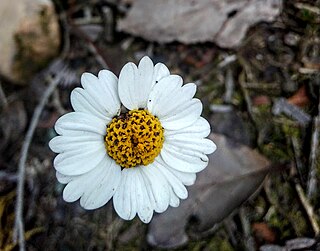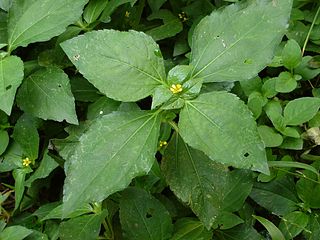
Sanvitalia ), the creeping zinnias, is a genus of flowering plants belonging to the family Asteraceae. They are native to mostly to Mexico, with a few species in Central America, South America, and the Southwestern United States.

Sonchus arvensis, the field milk thistle, field sowthistle, perennial sow-thistle, corn sow thistle, dindle, gutweed, swine thistle, or tree sow thistle, is a species of flowering plant in the family Asteraceae. S. arvensis often occurs in annual crop fields and may cause substantial yield losses.

Oblivia is a genus of flowering plant in the tribe Heliantheae within the family Asteraceae.

Pseudogynoxys is a genus of flowering plant in the groundsel tribe within the sunflower family, native to North and South America.

Acourtia is a genus of flowering plants in the family Asteraceae and was first described as a genus in 1830. It includes desertpeonies, such as Acourtia nana and Acourtia runcinata.
Critoniadelphus is a genus of flowering plants in the family Asteraceae.

Peteravenia is a genus of Mesoamerican plants in the tribe Eupatorieae within the family Asteraceae.
Trigonospermum is a genus of Mesoamerican plants in the family Asteraceae.
Espejoa is a genus of Mesoamerican flowering plants in the daisy family.
Westoniella is a genus of Costa Rican shrubs in the tribe Astereae within the family Asteraceae.
Wamalchitamia is a genus of Mesoamerican flowering plants in the family Asteraceae.

Sabazia is a genus of Colombian and Mesoamerican plants in the tribe Millerieae within the family Asteraceae.
Lepidonia is a genus of Mesoamerican flowering plants in the family Asteraceae.
Spiracantha is a genus of flowering plants in the tribe Vernonieae within the family Asteraceae.

Synedrella is a genus of flowering plants in the family Asteraceae.
Philactis is a genus of Mexican plants in the tribe Heliantheae within the family Asteraceae.

Crusea is a genus of angiosperms in the family Rubiaceae. The genus is found in the south-western United States, Mexico, and Central America. A few species are naturalized in Cuba and Puerto Rico.
Trixis inula, the tropical threefold, is a plant species native to Texas, Mexico, Central America, northern South America, and the West Indies. It is found on open, sandy sites such as roadsides, thorn scrub, thickets, etc.

Cyrtocymura is a genus of Latin American and Caribbean plants in the tribe Vernonieae within the family Asteraceae.
Rubus vulcanicola is an uncommon Central American species of brambles in the rose family. It has been found only in Panamá and Costa Rica. The species was initially discovered on the sides of Volcán Poas in Costa Rica.










